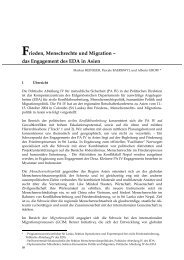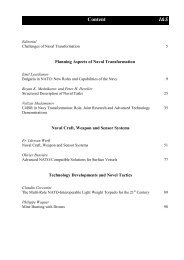Andreas Stamm Eva Dantas Doris Fischer Sunayana ... - ETH Zürich
Andreas Stamm Eva Dantas Doris Fischer Sunayana ... - ETH Zürich
Andreas Stamm Eva Dantas Doris Fischer Sunayana ... - ETH Zürich
Create successful ePaper yourself
Turn your PDF publications into a flip-book with our unique Google optimized e-Paper software.
20<br />
# of prototypes /<br />
units, deployed,<br />
market penetration<br />
(indicative)<br />
Wave and tidal<br />
Novel PV<br />
W ave and tidal<br />
Biomass<br />
advanced<br />
conversion<br />
Micro-CHP<br />
Technological maturity by stage<br />
Offshore Wind<br />
Biomass fuels<br />
Onshore<br />
wind<br />
Conventional<br />
PV<br />
(Germany)<br />
R&D Demonstration Pre-commercial Supported<br />
commercial<br />
<strong>Andreas</strong> <strong>Stamm</strong> et al.<br />
scale. It calls for internationally coordinated R&D activities in order to shorten the<br />
time required to make these technologies ready for quick deployment. These efforts<br />
should include all countries with advanced scientific and technological capabilities.<br />
— Even where technologies are relatively mature, a multitude of factors may explain why<br />
technology transfer – assuming willingness on both the side of technology provider and<br />
technology taker – is a complex task, especially when this transfer is to be managed<br />
across distance (without face-to-face contact) and in an intercultural setting. The transfer<br />
of technologies that go beyond simple-to-use artefacts (e.g. mobile phones) can be<br />
successful only where a certain level of technological mastery (Dahlman / Westphal<br />
1982; Katz 1987; Lall 1987) is found. For instance, the already-mentioned solar photovoltaic<br />
(PV) panels, even though they can increasingly been seen as a globally available<br />
industrial commodity, will only reach significant levels of roll-out if they are integrated<br />
into more complex systems (solar home systems, hybrid mini-grids) that require certain<br />
levels of capability in system integration, monitoring and maintenance.<br />
— Technological artefacts generated in the North, especially in areas like agriculture or<br />
health, are often not ready to be applied in the South but need first “to be translated<br />
to the ecological specificities of a different part of the world” (Sachs 2002, 8).<br />
— Finally, technological knowledge has important tacit components, elements that are<br />
difficult to codify and thus “sticky” and difficult to transfer to other locations. Especially<br />
Box 2: Technological maturity of selected clean energy technologies<br />
Combined<br />
Heat and<br />
Power (CHP)<br />
Biomass<br />
combustion<br />
Biomass co-firing<br />
Fully<br />
commercial<br />
This graph can only illustrate the overall situation, that may vary between countries and change within few years.<br />
Foxon et al (2005) classify conventional PV as belonging to the “pre-commercial” stage in the case of UK. In Germany,<br />
however, due to a very attractive feed-in tariff, solar PV may clearly be classified as a “supported commercial”<br />
technology.<br />
Source: Foxon et al. (2005b), slightly modified<br />
German Development Institute / Deutsches Institut für Entwicklungspolitik (DIE)
















